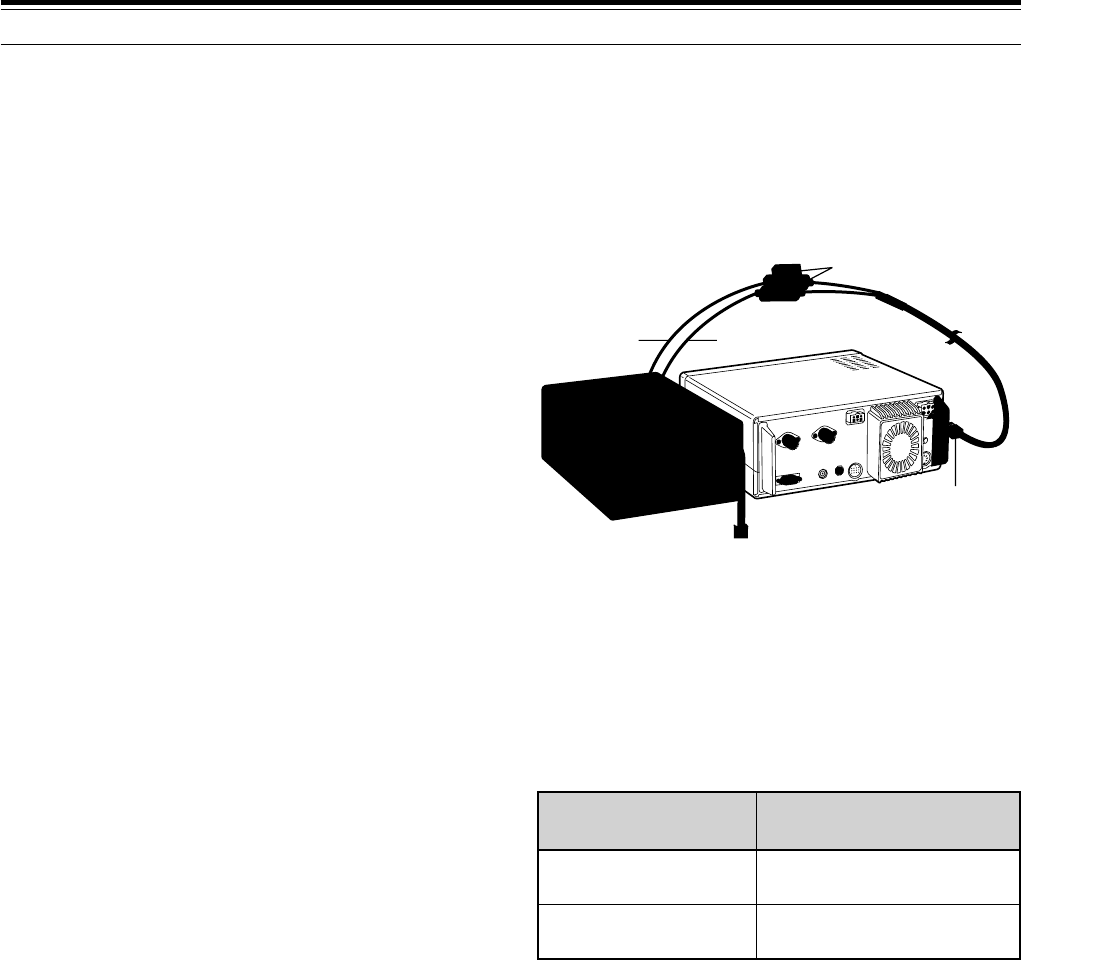
2
First connect the DC power cable to the regulated DC
power supply and check that polarities are correct
(Red: positive, Black: negative). Then connect the
connectorized end of the DC power cable to the
DC13.8V power connector on the transceiver rear
panel. Press the DC power cable connector firmly into
the connector on the transceiver until the locking tab
clicks.
REPLACING FUSES
If the fuse blows, determine the cause then correct the
problem. After the problem is resolved, only then
replace the fuse. If newly installed fuses continue to
blow, disconnect the power plug and contact your
dealer or nearest Service Center for assistance.
CAUTION:
REPLACE BLOWN FUSES ONLY AFTER
INVESTIGATING AND CORRECTING THE CAUSE OF THE
FAILED FUSE. ALWAYS REPLACE A BLOWN FUSE BY A NEW
FUSE WITH THE SPECIFIED RATINGS.
1 INSTALLATION
GROUND CONNECTION
At the minimum, a good DC ground is required to
prevent such dangers as electric shock. For superior
communications results, a good RF ground is required,
against which the antenna system can operate. Both of
these conditions can be met by providing a good earth
ground for your station. Bury one or more ground rods,
or a large copper plate under the ground, and connect
this to the transceiver GND terminal. Use heavy gauge
wire or a copper strap, cut as short as possible, for this
connection. Just as for antenna work, all connections
must be clean and tight.
LIGHTNING PROTECTION
Consider carefully how to protect your equipment and
your home from lightning. Even in areas where
lightning storms are less common, there are usually a
limited number of storms each year. Take the time to
study the best way to protect your installation from the
effects of lightning by consulting reference material on
the subject.
The installation of a lightning arrestor is a start, but there
is more that you can do. For example, terminate your
antenna system transmission lines at an entry panel
that you install outside your home. Ground this entry
panel to a good outside ground, and then connect
appropriate feed lines between the entry panel and your
transceiver. When a lightning storm occurs, you can
ensure added protection by disconnecting the feed lines
from your transceiver.
CAUTION:
DO NOT ATTEMPT TO USE A GAS PIPE (WHICH IS
CLEARLY DANGEROUS), AN ELECTRICAL CONDUIT (WHICH
HAS THE WHOLE HOUSE WIRING ATTACHED AND MAY ACT
LIKE AN ANTENNA), OR A PLASTIC WATER PIPE FOR A
GROUND.
DC POWER SUPPLY CONNECTION
In order to use this transceiver, you will need a separate
13.8 V DC power supply that must be purchased
separately. DO NOT directly connect the transceiver to
an AC outlet! Use the supplied DC power cable to
connect the transceiver to a regulated power supply. Do
not substitute a cable with smaller gauge wires. The
current capacity of your power supply must be 20.5 A
peak or more.
CAUTION:
◆
BEFORE CONNECTING THE DC POWER SUPPLY TO THE
TRANSCEIVER, BE SURE TO SWITCH THE TRANSCEIVER
AND THE DC POWER SUPPLY OFF.
◆
DO NOT PLUG THE DC POWER SUPPLY INTO AN AC
OUTLET UNTIL YOU MAKE ALL CONNECTIONS.
Fuse Location
Fuse Current Rating
Supplied Accessory
Cable
25 A
TS-570
4 A
(For an external antenna tuner)
DC power supply
TS-570
Black
Red
Fuse holders
DC 13.8 V


















